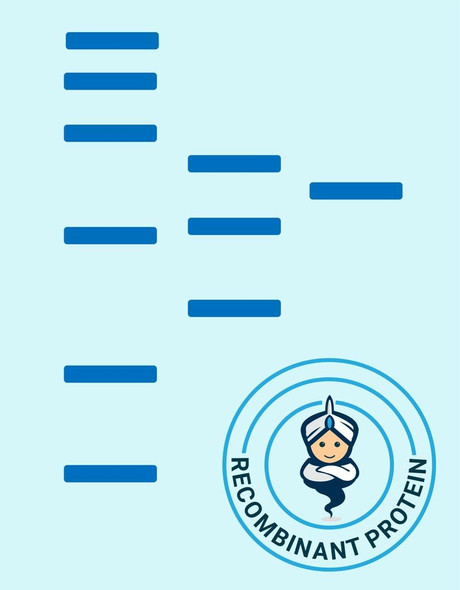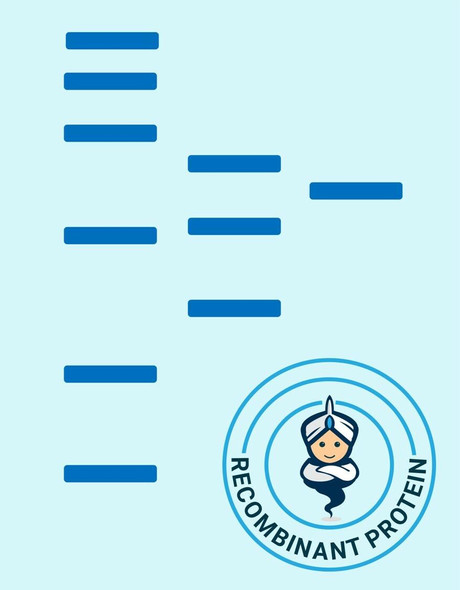Human CLTA Recombinant Protein (RPPB3209)
- SKU:
- RPPB3209
- Product Type:
- Recombinant Protein
- Species:
- Human
- Uniprot:
- P09496
Description
| Product Name: | Human CLTA Recombinant Protein |
| Product Code: | RPPB3209 |
| Size: | 20µg |
| Species: | Human |
| Target: | CLTA |
| Synonyms: | Clathrin light chain A, Lca, CLTA. |
| Source: | Escherichia Coli |
| Physical Appearance: | Sterile Filtered colorless solution. |
| Formulation: | CLTA protein solution (1mg/ml) containing 20mM Tris-HCl buffer (pH 8.0), 0.1M NaCl and 10% glycerol. |
| Stability: | Store at 4°C if entire vial will be used within 2-4 weeks. Store, frozen at -20°C for longer periods of time. For long term storage it is recommended to add a carrier protein (0.1% HSA or BSA).Avoid multiple freeze-thaw cycles. |
| Purity: | Greater than 90.0% as determined by SDS-PAGE. |
| Amino Acid Sequence: | MGSSHHHHHH SSGLVPRGSH MGSHMAELDP FGAPAGAPGG PALGNGVAGA GEEDPAAAFL AQQESEIAGI ENDEAFAILD GGAPGPQPHG EPPGGPDAVD GVMNGEYYQE SNGPTDSYAA ISQVDRLQSE PESIRKWREE QMERLEALDA NSRKQEAEWK EKAIKELEEW YARQDEQLQK TKANNRAAEE AFVNDIDESS PGTEWERVAR LCDFNPKSSK QAKDVSRMRS VLISLKQAPL VH |
Clathrin, light chain A (CLTA) is a member of the clathrin family. Clathrin, which is a large, soluble protein, is comprised of heavy and light chains. CLTA is one of 2 clathrin light chain proteins which are supposed to function as regulatory elements. CLTA is a key cytosolic coat protein in pits and vesicles originating from the plasma membrane and the trans-Golgi network. In receptor-mediated endocytosis, receptor proteins are encapsulated by Clathrin-coated vesicles.
CLTA Human Recombinant produced in E.Coli is a single, non-glycosylated polypeptide chain containing 242 amino acids (1-218 a.a) and having a molecular mass of 26.2kDa (Molecular weight on SDS-PAGE will appear higher).CLTA is fused to a 24 amino acid His-tag at N-terminus & purified by proprietary chromatographic techniques.
| UniProt Protein Function: | CLTA: Clathrin is the major protein of the polyhedral coat of coated pits and vesicles. Belongs to the clathrin light chain family. 4 isoforms of the human protein are produced by alternative splicing. |
| UniProt Protein Details: | Protein type:Motility/polarity/chemotaxis; Vesicle Chromosomal Location of Human Ortholog: 9p13 Cellular Component: clathrin coat of trans-Golgi network vesicle; clathrin coat; intracellular membrane-bound organelle; membrane; cytoplasmic membrane-bound vesicle; plasma membrane; trans-Golgi network membrane; cytosol; clathrin coat of coated pit Molecular Function:protein binding; clathrin heavy chain binding; structural molecule activity; peptide binding Biological Process: negative regulation of epidermal growth factor receptor signaling pathway; epidermal growth factor receptor signaling pathway; axon guidance; intracellular protein transport; nerve growth factor receptor signaling pathway; antigen processing and presentation of exogenous peptide antigen via MHC class II; endocytosis; post-Golgi vesicle-mediated transport |
| NCBI Summary: | Clathrin is a large, soluble protein composed of heavy and light chains. It functions as the main structural component of the lattice-type cytoplasmic face of coated pits and vesicles which entrap specific macromolecules during receptor-mediated endocytosis. This gene encodes one of two clathrin light chain proteins which are believed to function as regulatory elements. Alternative splicing results in multiple transcript variants. Related pseudogenes have been identified on chromosomes 8 and 12. [provided by RefSeq, May 2010] |
| UniProt Code: | P09496 |
| NCBI GenInfo Identifier: | 116501 |
| NCBI Gene ID: | 1211 |
| NCBI Accession: | P09496.1 |
| UniProt Related Accession: | P09496 |
| Molecular Weight: | 33kDa |
| NCBI Full Name: | Clathrin light chain A |
| NCBI Synonym Full Names: | clathrin light chain A |
| NCBI Official Symbol: | CLTA�� |
| NCBI Official Synonym Symbols: | LCA�� |
| NCBI Protein Information: | clathrin light chain A |
| UniProt Protein Name: | Clathrin light chain A |
| Protein Family: | Clathrin |
| UniProt Gene Name: | CLTA�� |
| UniProt Entry Name: | CLCA_HUMAN |










